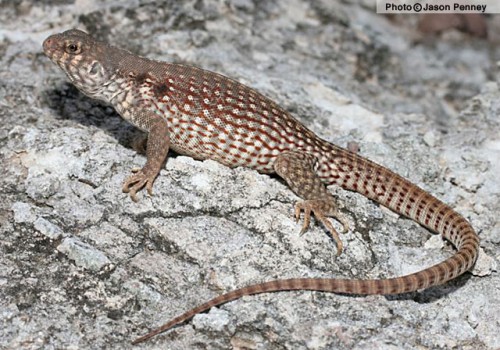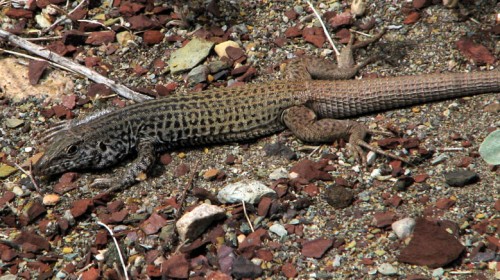Yard list: Desert Iguana, spotted
The first day of autumn has been a red letter day in our yard. Not only was there a Western screech owl calling last night — a new species for the yard, as far as my observations go — but this afternoon, in the heat of the day, a young Desert iguana raced under a creosote bush in the front yard, when I went out to get the mail.
I whipped out my tiny Canon Elph but the little ‘zard was all warmed up from hanging out in the midday sun, and it sped away before hiding in the shade under the creosote where I could see him but couldn’t get a picture. So I pinched this nice photo by Jason Penney from the excellent Reptiles of Arizona website which you can check out for more detailed info about this lizard. When full grown, Desert iguanas (Dipsosaurus dorsalis) are large lizards — almost 6″not counting tail and up to 16″with it — with a blunt face, long tail, and distinctive buffy coloration below a colorful pattern of speckles. This little guy shone pale gold as it raced across the cement driveway; its color gave away its identity even before I got close enough to see him well. Tiger whiptails (Aspidoscelis tigris) the lizards we see most often around here, are darker and lower to the ground.
The little iguana was also exhibiting another trait of its kind: it was out in the hot part of the day, when most other lizards have retired to shaded shelter or underground to rest and digest their forage. Diet is another thing that makes Desert iguanas distinct from our other lizards — they’re largely herbivorous when mature, eating a variety of desert vegetation, including the yellow flowers of creosote bushes, which they will climb to feast on. The first Desert iguana I ever saw was among the spring wildflowers at the Desert Botanical Garden, grazing in the hot sun like a small-scale reptilian cow, even leaving behind it large (for a lizard) fibrous pellets of poop like plant-eaters do. And, yes, they are related to their better known cousins, the Green “Tastes Like Chicken” Iguanas (Iguana iguana) of Mexico and Central America. I don’t know what something that feeds on pungent creosote blooms would taste like.
But this is why seeing him was especially exciting: there are only a few in the neighborhood, and that number appears to be shrinking, at least by informal observation. It’s only a theory, but mortality of Desert iguanas (specifically in our neighborhood) seemed to accelerate after the City re-coated our streets with a dark sealant. It makes for good basking, perhaps, the dark surface heating up earlier and staying warm later than the old gray road, and sadly, for several weeks, I would see Desert iguana roadkill regularly: three along one stretch of a heavily-used street nearby alone. So, seeing this little guy who was perhaps this year’s hatch, or more likely a yearling, was a very welcome sight.
Etymological notes:
Dipsosaurus is constructed of Greek elements, meaning “thirsty lizard”; dorsalis refers to the spine, which in Desert iguanas is protected by prominent, keeled scales.
Aspidoscelis tigris: Aspidoscelis is also from Greek elements, and means “shield leg” because of the sturdy scales on the whiptail’s legs, and “tigris” because it is stripy.


[…] street, swishing its long tail slowly back and forth before it fled the camerazza (me). Click here for an earlier Three Star Owl post on our neighborhood iguanas, here for more species info, and […]